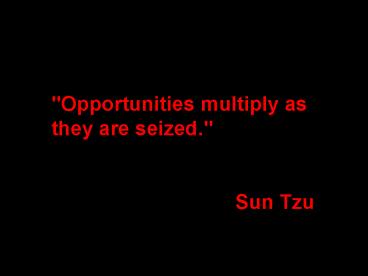Opportunities multiply as they are seized' - PowerPoint PPT Presentation
1 / 21
Title:
Opportunities multiply as they are seized'
Description:
The Calvin cycle uses ATP and NADPH to convert CO2 into sugar. The Calvin cycle has three phases & occurs in the stroma ... of carbohydrate & can exit the cycle ... – PowerPoint PPT presentation
Number of Views:44
Avg rating:3.0/5.0
Title: Opportunities multiply as they are seized'
1
"Opportunities multiply as they are seized."
Sun Tzu
2
Photosynthesis
Photosynthesis capture light energy from the sun
and convert it into chemical energy stored in
organic molecules 6CO2 6H2O light ? C6H12O6
6O2 Photoautotrophs C CO2
Photoheterotrophs C organic carbon
Foundation of energy for most ecosystems Source
of oxygen
3
Anoxygenic dont form oxygen as a product of
photosynthesis Oxygenic (our focus) form oxygen
as a product of photosynthesis (ex. Cyanobacteria
and plants)
4
Solar energy and light
The electromagnetic spectrum
Pigment molecules absorb some wavelengths of
light reflect others Chlorophyll a green
photosynthetic pigment associated with membranes
and chloroplasts
5
(No Transcript)
6
(No Transcript)
7
When a molecule absorbs a photon, one of that
molecules electrons is elevated to an orbital
with more potential energy
Excited electrons are unstable they drop to
their ground state in a billionth of a second
8
- In the thylakoid membrane, chlorophyll is
organized along with proteins into photosystems
A photosystem acts like a light-gathering
antenna complex consisting of a few hundred
chlorophyll
9
Light dependent reaction of P.S.
10
(No Transcript)
11
Potential energy
12
Chemiosmosis
At the end of the light dependent Rx we end up
with ATP and NADPH
13
Fig. 10.4
14
The Calvin cycle uses ATP and NADPH to convert
CO2 into sugar
15
Each CO2 molecule is attached to a five-carbon
sugar, ribulose bisphosphate (RuBP) by rubisco
16
The six-carbon intermediate splits in half to
form two molecules of 3-phosphoglycerate per CO2
17
Each 3-phosphoglycerate receives another
phosphate group from ATP to form 1,3
bisphosphoglycerate
18
A pair of electrons from NADPH reduces each 1,3
bisphosphoglycerate to G3P
19
If our goal was to produce one G3P net, we would
start with 3 CO2 (3C) and 3 RuBP (15C) We would
have six molecules of G3P (18C) 1 G3P (3C) is a
net gain of carbohydrate can exit the cycle
The other 5 G3P (15C) must remain in the cycle
to regenerate three RuBP These 5 G3P molecules
are rearranged to form 3 RuBP molecules
20
(No Transcript)
21
(No Transcript)































